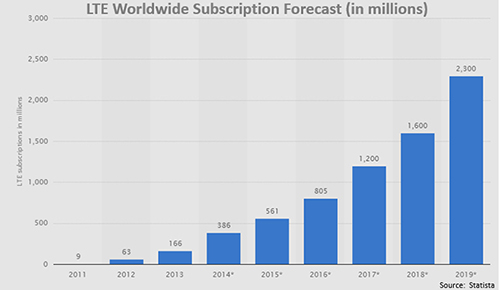Market Trends
LTE is the primary high speed wireless communication technology in portable devices worldwide
LTE technology, developed by contributing technology leaders and members of the 3GPP standards committee, has become the mainstream high speed wireless communication technology in portable devices worldwide, overtaking earlier wireless communication standards such as GSM/EDGE and CDMA. LTE’s enhanced data speeds enable faster downloading, uploading, and streaming of entertainment and media on mobile devices, helping drive the rise in global demand for LTE devices and networks. Worldwide LTE mobile phone sales are expected to reach 1 billion in 2016 and increase by almost 600 million units annually between 2015 and 20181. Historically, the United States led the rest of the world in LTE adoption, rising from 6.5 million units sold in 2011 to 129 million units sold in 2014 (resulting in a CAGR of 111%)1. The U.S. market now stands at nearly full market penetration, with continued sales being driven by new products and releases. The Asia Pacific region is expected to lead future growth in LTE mobile phone sales, rising from an estimated 405 million units sold in 2015 to 760 million units sold in 2019, representing a 13% CAGR1. Europe is forecasted to be another source of growth for LTE, with mobile phone sales expected to rise from 113 million units sold in 2015 to 172 million units sold in 2019, representing a 9% CAGR1. This anticipated rise in mobile devices is supported by the growth in LTE networks available to consumers by mobile carriers, which has exploded over the past five years from 16 commercially launched LTE networks to 422 LTE networks as of July 2015 according to the Global mobile Suppliers Association (GSA). Carriers worldwide are adopting LTE at a fast pace as it offers benefits such as efficient spectrum utilization and allocation, reduced costs, improved system capacity and coverage, and higher data rates with reduced latency.



1 Source: IDC.